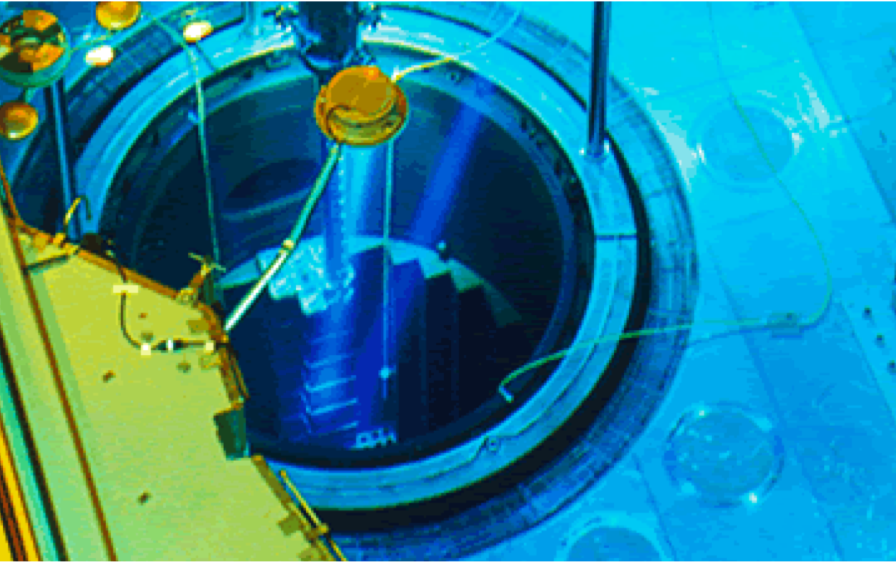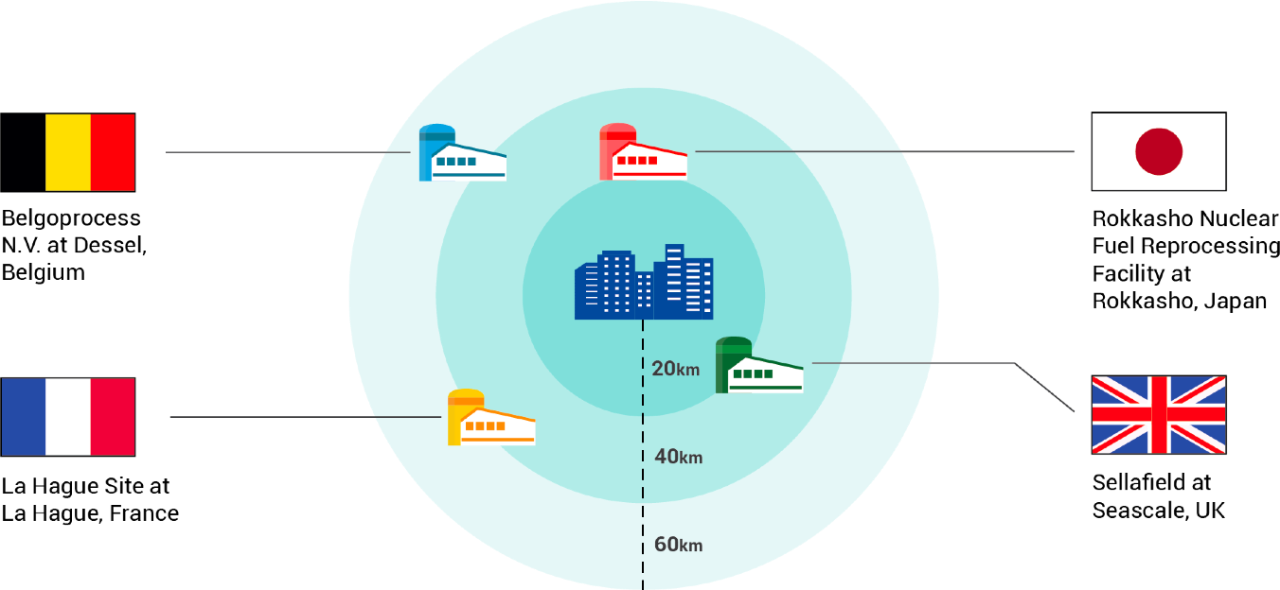Nuclear Power - Principle
In a nuclear power reactor, uranium 235 (U-235) undergoes nuclear fission in a controlled manner to produce a steady supply of heat. Normally, low enrichment U235 at typically below 5% is used for the generation. A collision of an injected neutron and fuel U-235 produces heat and emits two or three high energy neutrons. This process is called nuclear fission. Following the first fission, the emitted neutrons further collide with fuel and then the “chain reaction” occurs. With a proper control of fission rate, the number of neutrons used to bombard U-235 atoms remains constant for power generation.
Nuclear power generating units are classified according to their nuclear reactors. There are six main types in operation and fall into two main groups, according to the nature of the nuclear fission that takes place. In the first group, known as thermal-neutron reactors or simply thermal reactors, the neutrons are slowed down by a material known as moderator to enable nuclear fission to take place. In the second group, known as fast-neutron reactors or fast reactors, a moderator is not required. Of the six main types listed below, the first five types are thermal reactors and only the last is a fast-neutron reactor.
Main features of the main reactor types in operation
| Reactor Type | Main Countries | Fuel | Coolant | Moderator |
|---|---|---|---|---|
| Pressurised Water Reactor (PWR) | US, Japan, France, Russia, Germany, South Korea | Enriched UO2 | Water | Water |
| Boiling Water Reactor (BWR) | US, Sweden, Japan | Enriched UO2 | Water | Water |
| Pressurised Heavy Water Reactor (PHWR) | Canada | Natural UO2 | Heavy Water | Heavy Water |
| Light Water Graphite-moderated Reactor (LWGR) | Russia | Enriched UO2 | Water | Graphite |
| Gas-cooled Reactor (GCR) | UK | Natural U; Enriched UO2 | CO2 | Graphite |
| Fast-neutron Breeder Reactor (FBR) | Japan, Russia | Enriched PuO2 & UO2 | Liquid sodium | None |
The operation of a nuclear power station inevitably produces certain quantity of radioactive waste. In line with international practice, Daya Bay confines the majority of this waste, to prevent it from coming into contact with the environment.
The fission products and the small quantities of transmutation products extracted from spent nuclear fuel are highly radioactive relative to other radioactive waste products produced in the nuclear fuel cycle and are classified as a high level waste (HLW). While such material needs to be stored away from the environment to allow its radioactivity to decline to a level similar to its originating material, efforts are being made to develop technology to render the material so as to shorten the storage period. More information on the subject can be found in Spent Fuel and Nuclear Waste at Daya Bay.
Waste arising in the nuclear fuel cycle is classified into three categories:
1. Low Level Waste (LLW) is produced at various stages of operation. In a nuclear power station, it is the consumable material such as contaminated tools, wastepaper and discarded protective clothing. Radioactivity of some of them is lower than natural substances. Daya Bay produces typically less than 75 cubic metres of packaged LLW per year.
2. Intermediate Level Waste (ILW) is produced during reprocessing and normal reactor operation. In a nuclear power station, it is the operational waste such as primary cooling water treatment sludges and resin. Radioactivity is higher than natural substances. Normally, it is stored in the concrete shielding package. Daya Bay produces typically less than 75 cubic metres of such packaged waste each year.
3. High Level Waste (HLW) is sufficiently radioactive and produces decay heat. Thus, HLW requires cooling and shielding, and ultimately long term storage in a geologically stable location deep underground. In a nuclear power station, HLW arises from the 'burning' of uranium fuel and represents the fission products and transuranic elements extracted from the spent nuclear fuel after reprocessing. However, in the nuclear power stations of some countries that do not practice reprocessing, the spent nuclear fuel is classified as HLW. The spent nuclear fuel of Daya Bay has been transferred away from the power station after 8 years of storage for radioactive decay and cooling for subsequent reprocessing. From the quantity of spent fuel produced at Daya Bay, about 2.5 tonnes of HLW will be generated each year following reprocessing.
Practically, the LLW and ILW will be isolated from the environment for about 300 years for radioactivity reduce to natural levels. While the HLW needs to be stored for a very long period of time, the quantity is small so that storage is technically manageable.
Total Volume of Nuclear Waste
Lightly-contaiminated items like tools and work clothing containing only 1% of radiocativity in the nuclear waste
Used filters, steel components from within the reactor and some effluents from reprocessing containing 4% of radioactivity in the nuclear waste
Spent fuel containing 95% of radioactivity in the nuclear waste
The nuclear fuel that has been expended in the reactor during the fission process is known as spent fuel. Spent fuel assemblies are removed from the reactor during refuelling and held underwater in a fuel storage pool in the fuel building.
Managing Spent Fuel

Russia
Japan
France
UK
Spent nuclear fuel contains about 95% uranium 238 (U-238), 1% plutonium 239 (Pu-239) and other plutonium nuclides , 4% of highly radioactive fission products arising from the fission of U-235. In a reprocessing facility, the spent fuel is separated by chemical processes into three components: uranium, plutonium and the remainder which collectively is known as high level waste (HLW). Reprocessing enables the uranium and plutonium to be recycled into fresh fuel, and reduces considerably the quantity of material that needs to be disposed. The uranium from reprocessing can be reused as the base material for fuel after undergoing conversion and enrichment. The plutonium can be directly made into an oxide to be mixed with uranium oxide, creating a mixed oxide fuel that can act as a substitute for U-235. This fuel can be used in a conventional nuclear power reactor. Alternatively, the plutonium can be used on its own as a fuel in a fast-neutron reactor. Direct spent fuel disposal typically requires the spent fuel assembly to be sealed and stored underground in a stable geologically formation. Disposal facilities are now being developed to allow retrievable storage of spent fuel, which still contains a significant quantity of untapped energy.
The Distance between Reprocessing Facilities and Nearby Town Centres

Read More About Nuclear Essential